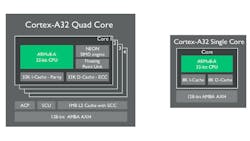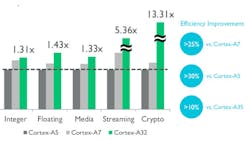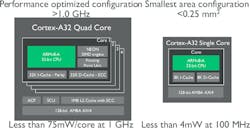ARM’s Cortex-A35 is a 64-bit core that is built around the ARMv8-A architecture. It is designed for entry-level smartphones (see “64-Bit Micro Targets Entry-Level Smartphones” on electronicdesign.com) and Internet of Things (IoT) applications (see “64-bit ARM Platforms Target the IoT Cloud” on electronicdesign.com). It was at the other extreme from the high-performance, 64-bit Cortex-A57 that tackles everything from high-end smartphones to SDN/NFV applications (see “Cortex-A57 SoC Targets SDN/NFV Applications” on electronicdesign.com).
It was a surprise to hear about ARM’s new 32-bit Cortex-A32 core that is built around the ARMv8-A architecture. It targets low-power applications such as mobile IoT devices. The Cortex-A32 provides an upgrade path from the current Cortex-A5 and Cortex-A7 processors.
Of course, a 32-bit core can be smaller than a 64-bit core and footprint is often indicative of power requirements as well. Plus, quite a few IoT applications can be easily addressed with a 32-bit part.
One reason for moving to the Cortex-A32 is to take advantage of the newer architecture that includes more than 100 new instructions (Fig. 1). These new instructions address a number of areas, including enhanced floating point support, better encryption support, and improved multimedia rendering.
The Cortex-A32 allows developers to take advantage of the new instructions and architecture to provide more performance while being more power-efficient (Fig. 2). The platform also supports ARM’s TrustZone security, including secure boot and trusted execution.
The Cortex-A32 will be available in configurations up to four cores (Fig. 3). A single core can use as little as 4 mW/100 MHz. A four-core system uses more, but 75 mW/core is very good for a 1 GHz operating frequency. Of course, a four core system can run a single core at a low frequency to gain power efficiency.
ARM’s 64-bit architecture offers developers an upgrade path, but the Cortex-A32 allows developers to gain most of the new features available in the 64-bit platforms while retaining the 32-bit environment with its better space and power efficiency. The big advantage is the compatibility with the existing 32-bit Cortex-A processors.
The nomenclature may be a bit confusing, given the bit-size differences between it and the Cortex-A35, but the Cortex-A32 will likely be the platform of choice moving forward for the low end of the Cortex-A marketplace.
About the Author
William G. Wong
Senior Content Director - Electronic Design and Microwaves & RF
I am Editor of Electronic Design focusing on embedded, software, and systems. As Senior Content Director, I also manage Microwaves & RF and I work with a great team of editors to provide engineers, programmers, developers and technical managers with interesting and useful articles and videos on a regular basis. Check out our free newsletters to see the latest content.
You can send press releases for new products for possible coverage on the website. I am also interested in receiving contributed articles for publishing on our website. Use our template and send to me along with a signed release form.
Check out my blog, AltEmbedded on Electronic Design, as well as his latest articles on this site that are listed below.
You can visit my social media via these links:
- AltEmbedded on Electronic Design
- Bill Wong on Facebook
- @AltEmbedded on Twitter
- Bill Wong on LinkedIn
I earned a Bachelor of Electrical Engineering at the Georgia Institute of Technology and a Masters in Computer Science from Rutgers University. I still do a bit of programming using everything from C and C++ to Rust and Ada/SPARK. I do a bit of PHP programming for Drupal websites. I have posted a few Drupal modules.
I still get a hand on software and electronic hardware. Some of this can be found on our Kit Close-Up video series. You can also see me on many of our TechXchange Talk videos. I am interested in a range of projects from robotics to artificial intelligence.




